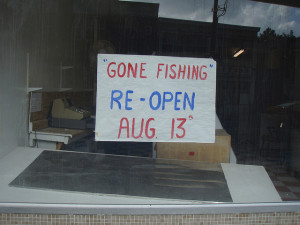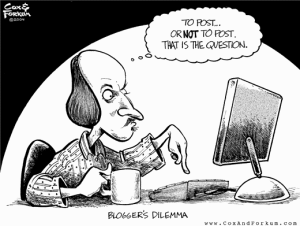C.J. Hayden's Blog
August 24, 2015
What If You Were Wrong About Marketing?
 Lately, I’ve been playing the “what if you were wrong” game with my coaching clients. It goes like this:
Lately, I’ve been playing the “what if you were wrong” game with my coaching clients. It goes like this:
Client: Jane at XYZ Company hasn’t called me back. They must not want to hire me.
C.J.: What if you were wrong about that?
Client: Hmm, maybe I should call her and ask what’s up?
 In this example, a moment’s consideration about the possibility that his thinking might be off base transformed my client’s discouraged paralysis into productive action. Examining where you might be wrong about marketing can be an extremely useful exercise for any entrepreneur. Consider these examples:
In this example, a moment’s consideration about the possibility that his thinking might be off base transformed my client’s discouraged paralysis into productive action. Examining where you might be wrong about marketing can be an extremely useful exercise for any entrepreneur. Consider these examples:
Client: I don’t want to limit myself by choosing a target market. I think I’ll market my business to anyone who might need my services.
Coach: What if you were wrong about that?
Client: I might be spreading myself too thin if I market to everybody. Maybe it would be a good idea to narrow it down a bit.
Client: The economy is so bad right now, I’m never going to get any big-ticket business. I’d better concentrate on small contracts until things pick up again.
Coach: What if you were wrong about that?
Client: I guess that could be a mistake. I’ll never get any big-ticket business unless I ask for it, right?
Client: I introduced myself to all those prospects already. They’ll call me if they need me.
Coach: What if you were wrong about that?
Client: They could forget about me if they don’t hear from me in a while. Maybe I should try to keep in touch.
Client: I heard that social networking is the best way for solopreneurs to market themselves. I’m going to stop my other marketing and put all my effort into Facebook.
Coach: What if you were wrong about that?
Client: Maybe I should ask some other solopreneurs what their experience has been first.
Client: I don’t like making follow-up calls. It should do just as well to send emails instead.
Coach: What if you were wrong about that?
Client: I could lose out on a lot of sales if people don’t read my emails. Maybe I should make a few calls, too.
Client: I got a great offer from my professional association to run a display ad in the conference program. I bet it will bring in lots of clients.
Coach: What if you were wrong about that?
Client: Perhaps I should call my friend who advertised last year and see what results she had.
Client: Now that my website is up, I should start getting plenty of business online without having to do much about marketing.
Coach: What if you were wrong about that?
Client: Well, I think pay-per-click ads would be a great way to attract more clients to my website.
Coach: What if you were wrong about that, too?
Client: Maybe I shouldn’t let go my offline marketing until I see how well I do online.
As you can see, questioning your assumptions about marketing can lead to designing a much more solid strategy. You can try asking yourself what if you were wrong, but it can be even more powerful to have a friend, colleague, or coach ask you. And, as in the last example above, keep asking until you feel satisfied with your new conclusions.
There’s one more type of assumption about marketing you might want to question – not what you’re planning to do, but how you feel about doing it:
Client: Marketing is scary. It’s uncomfortable, too. I’ll never be any good at it.
Coach: What if you were wrong about that?
Client: I guess I can learn to do it better. Maybe then it won’t be so scary or uncomfortable.
The next time you decide to do something about marketing – or not do it – take a moment and play the “what if you were wrong” game. You may discover an entirely new perspective, and ultimately, be right more often.
August 17, 2015
Avoiding the Feast or Famine Trap
 It often seems that it’s the destiny of the independent professional to exist in a constant state of feast or famine. Either you are working day and night to keep up with client demands, or you’re wondering how much is left in your savings account and whether the phone will ever ring again.
It often seems that it’s the destiny of the independent professional to exist in a constant state of feast or famine. Either you are working day and night to keep up with client demands, or you’re wondering how much is left in your savings account and whether the phone will ever ring again.
 When you’re having a feast of business, there’s plenty of money coming in, you’re getting recognition for your talents, and your energy level is usually high. But you may also feel constantly pressed for time, have to disappoint some clients you can’t adequately serve, and lose out on future business because you can’t respond to new opportunities.
When you’re having a feast of business, there’s plenty of money coming in, you’re getting recognition for your talents, and your energy level is usually high. But you may also feel constantly pressed for time, have to disappoint some clients you can’t adequately serve, and lose out on future business because you can’t respond to new opportunities.
When a business famine strikes, you have the time to develop new business and provide good service to the clients you still have. But you may also be low on cash and not feeling so good about yourself, which gets in the way of effective marketing.
There’s a simple answer to this dilemma. You need to market for new clients consistently and persistently, no matter what state your business is currently in. But like many simple answers, this is not necessarily easy.
Here are some suggestions for how to always make time for marketing:
1. Sometimes the customer comes second.
If you spend all your time doing client work, you will go out of business. You need to set aside time not only for marketing, but to answer correspondence, keep up in your field, and oh yes, send out the invoices. Every time you rush to help a client with what they call an emergency, you set a precedent that you will be available on short notice. Learn to say no compassionately, but firmly, when client requests interfere with you running your business to your own benefit.
2. Establish a time budget for marketing.
It’s helpful to have two different time budgets — one for when you are busy, and one for when things are slow. If you’re busy, a minimal budget will keep your marketing rolling. In two hours per week, you can go to coffee, make phone calls, send out emails, or make contacts about speaking. When business is slow, you should increase your time budget up to 30-50% of your work week — more, if you aren’t doing any client work at all.
3. Make marketing a priority in your calendar.
Work expands to fill the time allotted to it. Think of the last time you wrote a proposal or page of web copy. If the deadline was a week away, you may have written and re-written until it was perfect. If the deadline was the same day, you probably miraculously completed it on time. If you block out marketing time in your calendar, and schedule other important activities around it, you will find that those other activities somehow get done. Treat your marketing time just like an appointment. If something truly urgent comes up, reschedule it; don’t just erase it.
4. Get your marketing done first.
Sit down at your desk in the morning, and before listening to voice mail, reading email, hopping on social media, or looking at your client projects, tackle whatever marketing activities are on your agenda for the day. Spend 15 minutes, an hour, or two hours — whatever makes sense for your current marketing time budget — and then start your regular day. This has the added benefit of allowing you to engage in marketing when you are fresh.
If despite your best efforts, you do hit a famine period, there are some things you can do:
1. Take advantage of the lull to make a plan.
This could be a new marketing plan, or it could be a business plan where you do some financial modeling or revisit your strategic direction. I usually do this myself during the month of December, when I can expect a seasonal slowdown as my regular clients take vacation time and new clients don’t want to begin until January.
2. Send out a reminder.
This could be in the form of a postcard, email broadcast, or social media posts, with an announcement, special offer, or helpful information for your target market. If you are thinking, “Send a reminder to who?,” you need to take some to time to update and…
3. Use your contact management system.
Every independent professional needs some type of contact management system to track your clients and prospects, whether it’s sheets of paper in a 3-ring binder, or software you access on your computer or phone. When business is slow, every potential client in your CMS who hasn’t heard from you in the last 30 days is worth a phone call or email. You are much more likely to get a client quickly from following up than you are from contacting someone new.
If you use a CMS, you’ll be able to…
4. Research where your business comes from.
If you track the source of every lead, you can then determine which sources actually delivered people who became clients, and then how much money each of those clients spent with you. It’s an extremely worthwhile use of some down time to find out which sources of business put the most money in your pocket, and then see what you can do to replicate them.
If you do a good job at consistent and persistent marketing, inevitably you will attract more business than you can handle, at least at certain times. Don’t be so afraid of this possibility that you allow it to hold back your marketing! If clients call and you are not available, many of them will wait for you. Having a waiting list makes you more desirable, and it also allows you to raise your rates because of the perceived demand for your services.
So don’t stay trapped in the feast or famine cycle. A steady diet of just enough clients will feed a happier, healthier, wealthier you.
August 11, 2015
Marketing with the 80/20 Rule
 You know about the 80/20 rule, right? It’s the guideline that 80% of your return comes from 20% of your investment. For example, 80% of your referrals come from 20% of the people in your network. 80% of your new business comes from 20% of your prospects. 80% of your new contacts come from 20% of the networking activities you engage in. And so on.
You know about the 80/20 rule, right? It’s the guideline that 80% of your return comes from 20% of your investment. For example, 80% of your referrals come from 20% of the people in your network. 80% of your new business comes from 20% of your prospects. 80% of your new contacts come from 20% of the networking activities you engage in. And so on.
 Like all such guidelines, this one is inexact, but helpful. If used correctly, it makes you stop and think. Where are most of your returns coming from? And where is most of your effort going? Imagine how much less time and money you could spend on marketing if you could simply identify the 20% of your current efforts that are really the only ones that matter. You could let go of 80% of what you’re doing.
Like all such guidelines, this one is inexact, but helpful. If used correctly, it makes you stop and think. Where are most of your returns coming from? And where is most of your effort going? Imagine how much less time and money you could spend on marketing if you could simply identify the 20% of your current efforts that are really the only ones that matter. You could let go of 80% of what you’re doing.
I can’t guarantee everyone can do this. Some of you are already pretty smart about how you market yourselves. But here are some places to look:
1. Where are your clients actually coming from? You may think you know the answer to this question, but I find in many cases that people’s assumptions don’t match the data. Review every client you’ve worked with in the past two years and try to determine how that client entered your life. Make a list of not just the source of each client, but what you may have done (or made available) to produce clients from that source.
For example, “Referred by Mary Smith. Met her for coffee last month,” or “Inquiry from my website. Signed up for my special report two weeks ago.” If you can’t uncover data like this about every new client, now is the time to start tracking it for the future.
Notice any patterns this analysis suggests, and strategize how you might reproduce these successes. Where could you find more referral sources like Mary Smith? Or what potential referral sources already in your network have you yet to meet for coffee? If most of the new clients originating from your website are those that requested your special report, is that request form available on every page?
2. Where are your highest paying or lowest hassle clients coming from? The quality of your clients can make as much difference to the success of your business as the quantity of them. Select the top 20% of your clients from the list you made above — either the ones that paid you the most or troubled you the least — and consider how you might acquire more clients like them.
Notice not just the source of these top clients, but also what characteristics they might share. You might discover that your highest paying clients are those who themselves are in a higher income bracket. Or that the clients who give you the least trouble are the ones who have worked with professionals in your line of business before. These are valuable clues to where the majority of your marketing efforts should go.
3. What marketing approaches are costing you more money than they bring in? When you can see exactly where your clients are coming from, you can also determine where you’re paying too much to get them. Common places for overspending are online and print directory listings, pay-per-click ads, search engine optimization fees, and multiple association memberships.
Compare not just what you are spending on each potential source of clients to what revenue you received from it, but what profit you ultimately made. A $500 ad that brought you a $500 client has earned you nothing. And an ad that produces many inquiries but little paying business consumes time you could better use to produce income.
4. What are you currently doing that you haven’t gotten a single client from? Some marketing techniques take time to pay off, but if you’ve been using a particular approach for several months and no clients have yet resulted, it’s time to reconsider. You probably need to either abandon this approach or fine-tune it.
If you belong to a networking group that isn’t producing referrals for you, consider whether you should seek a different group that’s a better match for your target market, or stick with the group and start meeting its members for coffee. If you’ve been cold calling corporate prospects without results, you may need to drop cold calling and focus on referrals and introductions.
By making judicious use of the 80/20 rule, you can eliminate the least productive marketing activities you engage in and ramp up those that are more effective. You can also focus most of your marketing on the client sources and type of prospects that have worked well for you in the past. And that can put you in the 20% of entrepreneurs who have a successful business instead of in the 80% who don’t.
July 31, 2015
Get Clients from Speaking: Be the Guest, Not the Host
 “I don’t recommend you host your own teleclass,” I told my client.
“I don’t recommend you host your own teleclass,” I told my client.
“Why not?” she asked. “I thought public speaking was a great way to get clients.”
“It is,” I replied. “But hosting your own free teleclass isn’t public speaking; it’s a promotional event.”
 Yep, there’s a big difference between a self-employed professional putting on his/her own show, and being invited as a guest presenter for someone else’s. When you consider the level of effort to make it happen, the cost of putting it together, and the amount of new business you can expect to get, public speaking — live or virtual — wins out over a promotional event almost every time. Here’s why.
Yep, there’s a big difference between a self-employed professional putting on his/her own show, and being invited as a guest presenter for someone else’s. When you consider the level of effort to make it happen, the cost of putting it together, and the amount of new business you can expect to get, public speaking — live or virtual — wins out over a promotional event almost every time. Here’s why.
1. Who’s on the invitation list — The reason you see high-profile professionals offering free teleclasses, webinars, and free or low cost local workshops is that they have a substantial number of prospects already in their database. With 10,000 targeted prospects on your email list, you might get 100 to register for a free teleclass or webinar, especially if you also promote it on social media. But if your list has 500 people on it, you’ll be lucky to get five.
When you speak for an established organization, they use their list of members, students, customers, or employees to promote your event. And it’s not just the size of their list that can be significant. When you speak for a regular gathering, as opposed to offering a one-time event, a higher percentage of the invitation list will register. That’s because they will have the gathering already on their calendars, and will have often paid a fee to even be invited.
If you offer the event audience a free gift or door prize, most of them will happily give you their contact information. Then you can add them to your list (with appropriate permission, of course), allowing you to follow up with them.
2. Time and money to promote — Promoting an event requires a considerable amount of effort over a substantial period of time. To do it well, you’ll need to invite people in multiple ways, and do so multiple times. You may have to send emails, post on social media, mail postcards, make phone calls, ask colleagues to invite friends, and more, just to fill the room.
But hosts for your speaking events do all this work for you. They have a mailing list, social media channels, a budget, and a promotion plan already in place, because they host speakers like you all the time. When you show up to speak, the room is already full.
3. Impact on your credibility — When an organization hosts you as a speaker, you get an implied endorsement from that group. The audience automatically thinks of you as an expert, which colors everything you say, including your offer to do business with those who attend. Hosting your own event doesn’t carry that level of credibility. It can even detract from how credible you are if your event attracts only a few people.
4. Potential of new business — In the Get Clients Now! hierarchy of marketing strategies, public speaking is rated the third most effective, while promotional events are rated as only fifth of six. The reasoning behind this includes all the factors stated above. Being a guest speaker makes you instantly credible, takes considerably less effort to achieve, and provides you with a new, larger, and more responsive potential audience, compared to producing your own speaking event.
If this is so, why do so many self-employed professionals try to host their own events? Here’s my guess:
They’re copying what they think they see modeled by higher-profile professionals, not considering that those folks may have much larger followings, experience with filling events, and probably some paid staff.
It seems easier to set up a bridge line, webinar platform, or conference room and invite some folks than it does to position themselves as experts so organizations will find them desirable as speakers.
Landing speaking engagements requires making requests that may be denied or ignored, exposing them to rejection. This brings up fear, resistance, and the inner critic.
“Ah hah!” said my client, when I explained this to her. “It’s the same as when you advised me not to buy a booth at that expo. I wanted to take the easy way out and just write a check instead of working on building my referral network.”
Smart client. You can be this smart, too. Design an attractive speaking topic, write a credible bio, and start reaching out to some potential hosts. Getting booked as a no-fee speaker can be easier than you think. Hosting your own free speaking events may seem like a shortcut to getting clients, but for too many professionals, it has instead been a dead end.
July 23, 2015
Summertime, and the Marketing Ain’t Easy
 Summer is here, but it seems many of your potential clients are not. When you get the response “I’ll be on vacation until…” one too many times, it’s easy to become discouraged about summertime marketing. But fear not, there’s plenty you can do to build your business in the summer months. Here are ten cool ideas for what to do while the weather is hot.
Summer is here, but it seems many of your potential clients are not. When you get the response “I’ll be on vacation until…” one too many times, it’s easy to become discouraged about summertime marketing. But fear not, there’s plenty you can do to build your business in the summer months. Here are ten cool ideas for what to do while the weather is hot.
 1. Network with colleagues. Many of your colleagues may be experiencing a slow time as well. This is the perfect opportunity to set up lunch, coffee, and phone dates to network with others who serve the same target market and build your referral base.
1. Network with colleagues. Many of your colleagues may be experiencing a slow time as well. This is the perfect opportunity to set up lunch, coffee, and phone dates to network with others who serve the same target market and build your referral base.
2. Attend some events. Look for networking opportunities in your local area that will allow you to make contact with folks in your niche. Summer calendars often include awards celebrations, fundraisers, golf tournaments, launch parties, expos, and other events with an element of fun.
3. Take time for projects. Tackle some of the important-but-not-urgent marketing projects you never seem to have time for. Update your ezine, revise your website copy, launch a blog, expand your social media networks, or implement a new contact management system.
4. Book speaking gigs for fall. Associations, networking groups, and brown bag lunch programs are lining up speakers now for their fall meetings. Compose descriptions of two or three topics that capture your expertise and reach out to program chairs, group leaders, and hosts.
5. Write that book. You’ve always wanted to write a book, right? Two slow months could give you plenty of time to write an ebook, workbook, white paper, case study, or other compilation of your words of wisdom. Not into writing? Record a series of audios or videos instead.
6. Make a special offer. Encourage clients to work with you now by offering an incentive. Discounts aren’t always the best choice for professionals, so consider get-acquainted offers like free consultations or demonstrations, and bonuses like extra sessions or add-on services.
7. Reconnect with former clients. It may not be the best time to connect with new prospects or get new projects started, but not everyone is on vacation. Take this opportunity to rekindle old relationships. Contact former clients by phone or email and find out what’s new in their world.
8. Schedule now for later. With the always-in-touch state of communications today, your prospects may still be connected even when out of the office or away from home. When you leave a message or send an email or text, suggest making an appointment for when they return.
9. Take a class, read a book, make a plan. Not sure what’s the best thing to do about marketing? This may be an excellent time to learn and strategize. Participate in a workshop or coaching group, read a sales or marketing book, or create a customized marketing plan.
10. Take time off yourself. Remember that you deserve a break this summer, too. Be sure to schedule your own vacation time. Reconnect with family and friends, with nature, or with yourself. Building your business is always easier once you’re rested and restored.
Summertime may be slow for business, but it doesn’t have to be a dead zone. Take steps to bring your marketing alive, and you’ll see more changes than just the weather by the time fall gets here.
July 2, 2015
What Are You Doing Right?
 “What’s wrong with my marketing?” That’s a question I often hear from clients, students, and readers. It’s a useful query, as there frequently are areas where you could do better at marketing and sales. But while the question “what’s wrong” can uncover your marketing problems, it doesn’t always suggest answers. You may need to ask what you’re doing right.
“What’s wrong with my marketing?” That’s a question I often hear from clients, students, and readers. It’s a useful query, as there frequently are areas where you could do better at marketing and sales. But while the question “what’s wrong” can uncover your marketing problems, it doesn’t always suggest answers. You may need to ask what you’re doing right.
Examining what’s already working about your marketing and sales activities can give you valuable clues to how you can improve. Here are some helpful questions to ask yourself, and what they might tell you about where your marketing efforts will produce the best results.
1. Where did your last few clients come from? Consider the new clients you’ve landed over the past year. Were they referred to you? Did they contact you through your website? Had they heard you speak? Did you cold call them? Examine the source of all your recent sales and determine exactly how you first came in contact, and what sequence of events led to closing those sales. If you notice a pattern, see how you might repeat your success.
One of my coaching clients, a graphic designer, was spending a considerable amount of her marketing time on approaching ad agencies and corporate marketing departments, with lukewarm results. She told me these had always been her best source of clients in the past, but I asked her to look at where her clients had been coming from lately.
She was surprised to discover that all her recent clients had been referrals from colleagues, such as a copywriter, a photographer, and an art director. When she switched the emphasis of her marketing away from knocking on the doors of large firms, and instead began networking with professionals in related fields, she began seeing better results almost immediately.
2. How have you gotten your best clients? Some clients give us repeat business, pay our fees without quibbling, and are easy to work with, while others want us to work at discount prices and jump through hoops to get and keep their business. Consider who your best clients have been over time, and what you did to find them. Are these approaches you can use again?
A marketing communications consultant in one of my classes was struggling with a demanding large client who paid below market rates. She had other, smaller clients who paid better and were much easier to work with. She realized that these small, well-paying clients were all people she had met through a trade association, while the demanding client was someone she had cold-called. Clearly she needed to stop cold calling and step up participation in the trade group.
3. Where do you get the strongest response from your marketing messages? In what environments do you find that people really connect with what you have to say? Where does it seem like “your people” are, or under what circumstances do you seem to attract potential clients without even trying? This can be a useful query to guide your marketing even if you’re new and haven’t made many sales yet.
One of my colleagues, a new business coach, was unsure whether to focus on small business owners or corporate executives as his target market, so he was approaching both. But he noticed that entrepreneurs seemed much more interested in talking to him than executives did, and quickly acquired several likely prospects who were all small business owners. He concluded that he could stop searching for his target market, because it seemed to have found him on its own.
4. What marketing activities feel most comfortable and natural to you? Let’s face it; when you’re self-employed, nobody is going to make you market yourself. Your marketing plan needs to consist of activities you are willing to do. Instead of beating yourself up for what you’re not doing, notice what marketing tactics you find to be easier and more attractive.
A change management consultant I was advising felt like a failure at marketing because he avoided attending networking events or calling strangers on the phone. But he realized he was quite comfortable with two types of marketing: writing articles, and having conversations with people he already knew. When he created a marketing plan centered around article writing and building one-to-one relationships, he was at last able to sell himself with ease.
No matter what is wrong with your marketing, there’s always a better way to go about it. Looking at what’s not working can only take you so far. Then it’s time to ask yourself what you’re already doing right.
June 16, 2015
Cold vs. Warm: What’s the Right Marketing Temperature?
 Are cold calls a good idea or a complete waste of time? What about pitching business via letters and emails – does writing to strangers pay off, or should you focus on contacting people you already know? When marketing online with a newsletter, blog, or social networking, should you reach out to folks who haven’t heard of you or stick to your existing network?
Are cold calls a good idea or a complete waste of time? What about pitching business via letters and emails – does writing to strangers pay off, or should you focus on contacting people you already know? When marketing online with a newsletter, blog, or social networking, should you reach out to folks who haven’t heard of you or stick to your existing network?
 These are important questions to devise an effective sales and marketing strategy, and they don’t always have black-and-white answers. First let’s define some terms.
These are important questions to devise an effective sales and marketing strategy, and they don’t always have black-and-white answers. First let’s define some terms.
A cold approach –- whether it’s a call, letter, email, sample issue of your publication, or friend request – is one you are making or sending to someone you have never interacted with and doesn’t know who you are. A warm approach is when you contact someone you have previously connected with, knows of you already, or has been personally referred to you by someone you both know.
Warm approaches are by their very nature more likely to be useful. If prospects know you or at least know your name, they will be much more inclined to take your call, open your mail, and be receptive to what you have to say. When you contact someone as the result of a referral, using the name of the person who sent you can have the same effect.
Cold approaches, on the other hand, more often lead to rejection. Calls may not be accepted or aren’t returned, letters and emails may stay unopened, and attempts at online contact may be ignored.
For most independent professionals, there are dozens of ways to make use of the warm approaches that are typically more productive. So why would you approach prospects cold when you have other, presumably better, choices for how to spend your marketing time?
Cold approaches are not necessarily an ineffective tactic. In fact, there are times it might make sense for you to use them. For example:
When you’re new in a geographic area or an industry and don’t really have many connections yet.
When you need to engage in some kind of interaction quickly to feel as if you are being proactive about marketing.
When you really like cold calling as an activity and feel comfortable and natural doing it.
When you would rather stay in your office writing and phoning than go out and meet with people in person. (Note than phoning does need to be part of this approach. Just writing letters and emails without also calling will rarely produce any clients.)
When your business is easily understood and prospects should already know if they need you or not, with little explanation.
When you live in a rural or isolated area, and the nature of your business (or your personality) doesn’t lend itself well to web-based promotion.
Cold approaches can sometimes feel easier than warm ones. Since you’re contacting only strangers, you don’t run the risk of being rejected by people you know. It’s easy to ignore the fact that your overall chance of rejection is considerably higher when approaching prospects cold.
Cold approaches can also seem to be faster. You don’t have to spend time building a network and getting to know people. Your hope is that you’ll place a call and your new prospect will agree to buy on the spot. Of course, this rarely happens. It can take considerably longer to close a sale from a cold approach than from a warm one, because you don’t have the same credibility.
Cold approaches may appear to be more direct, while networking and referral-building activities can sometimes feel a bit aimless. You don’t always know if you’re building relationships with the right people, or which of your contacts are going to produce results. Of course, you can be just as directed with networking and referral-building if you choose your targets as carefully as you would when cold calling.
But here’s the bottom line on the cold vs. warm question. Warm approaches can stand alone. You can have a powerful, focused sales and marketing plan based completely on warm approach tactics. Cold approaches, however, while they can sometimes be useful, can’t carry your whole plan. Including them in your overall mix of marketing activities can be helpful. But basing your entire marketing strategy on approaching prospects cold is usually a path to failure.
So rather than saying about cold calling and other varieties of cold approach, “don’t ever do it,” I’d say instead, “don’t ever rely on it.” Cold calls, letters, emails, and other cold contacts need to be combined with warm marketing techniques in order to see a substantial payoff from your marketing as a whole. And often, those warm marketing techniques will net you better results if you focus on them exclusively and forget about the cold ones.
May 28, 2015
How Much Do You Love Your Prospects?
 Does it seem strange to use the word love when referring to a business relationship? Substitute another word if you prefer — “like,” for example, or “respect.” However you want to express it, the point is to consider how much you care about the people you sell to — their needs, goals, desires, concerns — all the elements of their lives that might be involved in their decision about whether to buy from you.
Does it seem strange to use the word love when referring to a business relationship? Substitute another word if you prefer — “like,” for example, or “respect.” However you want to express it, the point is to consider how much you care about the people you sell to — their needs, goals, desires, concerns — all the elements of their lives that might be involved in their decision about whether to buy from you.
 If you don’t love your prospects, they will know it. We’ve all been sold to by someone who didn’t care about us. The salesperson who pressures us to buy a car with options we don’t need. Or the telemarketer who launches into a lengthy script without asking if she’s interrupting our dinner. Or the guru who entices us to purchase a high-priced solution without bothering to find out whether it has any relevance to our situation. We can feel their disregard, and it turns us off.
If you don’t love your prospects, they will know it. We’ve all been sold to by someone who didn’t care about us. The salesperson who pressures us to buy a car with options we don’t need. Or the telemarketer who launches into a lengthy script without asking if she’s interrupting our dinner. Or the guru who entices us to purchase a high-priced solution without bothering to find out whether it has any relevance to our situation. We can feel their disregard, and it turns us off.
On the flip side, you’ve probably had the pleasant experience of being sold to by someone who took the time to find out exactly what you needed, explored with you respectfully the match between what he had to offer and your desires, and allowed you to come to your own decision about the purchase. An experience like that not only makes you feel good about spending money, it makes you want to buy more from that person as soon as you can.
You know when people who are trying to sell to you care about you and when they don’t. You can sense it in what they say (and don’t say), the type of questions they ask (or don’t ask), how they listen to you (or don’t listen). You always know. And so do the people you are trying to sell to.
So how much DO you love your prospects? Do you look forward to spending time with them, or dread going to places where they gather? Do you enjoy talking with them on the phone, or find reasons to avoid calling? Do you take pleasure in learning more about their problems and goals, or resent the time it takes? Do you try to sell them only what they need, or hope to sell them anything you can? Whichever it is, you can bet that your prospects know it.
I’m not suggesting that you truly dislike your prospective clients. It may be that talking to them just makes you nervous. Or that selling brings up the fear of rejection. Or that you’re so focused on making a sale, you’re not really seeing the person you’re selling to. Whenever we’re anxious, or afraid, or intent on our own goals, we tend to become self-absorbed or defensive. As a result, we may hold ourselves aloof, or talk too much, or stop listening, or disregard what others want.
But those are the very same behaviors that other people interpret as “not caring.” You’re uncomfortable or hyper-focused, so you withdraw from others, ignore them, or override them. They feel your disregard, so they react by pulling away from you. You feel them pulling away, so you either give up — and lose the sale because you’re avoiding them — or try even harder — and lose the sale because you’ve alienated them. It’s a self-defeating cycle.
There is a way to break this pattern, but it’s not a new set of skills to learn or techniques to try. It’s simple but not easy; subtle but incredibly powerful.
Love your prospects.
Picture in your mind the ideal person to become your client — the sort of person you went into business to help. Imagine the problems they are having and the issues they are struggling with. Think about the goals they are working toward and the dreams that inspire them. Visualize them getting what they want and need, and what that would mean to them.
Now, what feelings do these thoughts evoke toward that client? Do you feel warm, friendly, connected? Thinking about their problems, do you feel sympathetic, supportive, encouraging? Imagining their goals, are you approving, enthusiastic, excited for them?
This authentic state of mind — a caring, supportive, loving attitude toward your prospective clients — will help you close more sales than any skills or techniques you could learn. And as an added bonus, it can help you become more comfortable with selling than you ever thought possible.
Whenever you find yourself struggling to make a sale, or to reach out to a prospect, stop what you’re doing. Take a few moments to consider all the reasons you care about that person. Even if you don’t know them, you know others like them. Ground yourself in an attitude of friendship, support, and respect. Then start again.
If you begin to really love your prospects, you may just find that they will love you back.
May 22, 2015
Seven Steps to Networking One-on-One
 Most of the dialogue about networking to build your business centers around attending events or social networking online. But I’ve always found that one-on-one networking is where the real magic happens. Meeting with people individually, in person or by phone, builds the “know, like, and trust” factor, generates referrals, connects you with new resources, and creates lasting relationships.
Most of the dialogue about networking to build your business centers around attending events or social networking online. But I’ve always found that one-on-one networking is where the real magic happens. Meeting with people individually, in person or by phone, builds the “know, like, and trust” factor, generates referrals, connects you with new resources, and creates lasting relationships.
 To people who are natural networkers, this type of connecting may come easily. But many entrepreneurs tell me they find the process of one-on-one networking mysterious, awkward, or daunting. Here are seven steps to help any entrepreneur become a master networker.
To people who are natural networkers, this type of connecting may come easily. But many entrepreneurs tell me they find the process of one-on-one networking mysterious, awkward, or daunting. Here are seven steps to help any entrepreneur become a master networker.
1. Choose who to network with.
Networking is not selling. While you might network with people who could become clients, your purpose is not to close a sale. The aim of a networking conversation is to build a mutually beneficial relationship. The benefit you’re seeking may be referrals to prospective clients, information about your market or field, or suggestions and resources to boost your success. The benefits most important to you should drive your choice of who to network with.
If you are seeking referrals, your best choice for networking will be people who are in regular contact with your target market. This usually means they are either in your target market themselves, or they serve it. A graphic designer serving entrepreneurs, for example, might choose to network with other entrepreneurs, preferably those with active networks of their own. Or she might network with photographers, web designers, and others with entrepreneurs as their market.
2. Plan your approach.
Before reaching out, determine the primary purpose for your contact. Perhaps you want to acquaint the other person with your business so he could refer to you in the future. Or you might like to learn what she knows about the high tech industry. Or you might want to find out where you could speak locally to reach corporate training directors.
Since networking is intended to be mutually beneficial, think about what you could offer the other person. Could you refer him business occasionally? Or can you provide useful information or ideas? If you’re not sure what you could provide, be prepared to ask, “How could I be helpful to you?” Make the offer of reciprocity, even when you don’t yet know what that might look like.
3. Reach out with a call or email.
Place a phone call or send an email, stating the reason for your contact. Suggest that the two of you set up a convenient time to meet in person or by phone.
You might say something like this: “I understand we both serve the health care industry, and we may be able to help each other be more successful. Could we get together and talk about that?”
Or like this: “I’d like to do more work with schools, and I know you’re well-connected in that world. Could I ask you to give me a few pointers? I’d be happy to return the favor if there’s some way I could be of assistance to you.”
Or this: “I’m interested in writing some articles for financial publications. Since you’ve been doing that for a while yourself, would you be willing to pass along some suggestions? Perhaps I could also help you with something you’re working on.”
4. Follow up if they don’t respond.
Don’t make one attempt and then give up, thinking the other person isn’t interested. You may have contacted him at a busy time, she may be ill or on vacation, your voice mail could have been accidentally deleted, or your email never arrived. Wait a week or two, then try again. Consider calling if you emailed before, or vice versa. If you still don’t hear back, wait a month and reach out again. Just be sure never to make the other person wrong for not replying before.
5. Meet in person or by phone.
In-person meetings are your best choice to connect with someone local. My own preference is to meet for coffee rather than a meal or drinks. That keeps the meeting shorter and usually more focused. Phone meetings are good for out-of-area connections, or when busy schedules don’t permit getting together.
Begin by asking for more details about the other person’s occupation, even if you think you know everything. Expressing interest in others will increase their comfort level in talking to you. Then tell them a bit about your own work to provide a context for your request. Next, ask for what you want from the meeting, and at the same time, make a reciprocal offer.
For example: “I’m looking for more referrals for my business, and I suspect you may be also. Could we exchange some information today that might help us refer to each other?” Or: “I’d like to get more doctors to refer their patients to me, and I was hoping you could give me some insights to help with that. And I’d like to find out what I might be able to help you accomplish.”
Never use a networking request to lure someone into a sales conversation unless you want to make an enemy for life. Only if the other person clearly expresses an interest in working with you should you turn the topic to how you might do business.
6. Follow up after you meet.
After your meeting, send a note thanking the other person for his time, and expressing your pleasure at getting to know him better. Include any supporting information relevant to your conversation, such as a link to your website, description of your ideal client, or copy of an article you’ve written.
7. Follow up over time.
If you felt your meeting was productive, stay in touch to keep the relationship alive. Suggest that your new acquaintance subscribe to your newsletter or blog, or connect with you on Facebook or LinkedIn. Reach out personally every three to four months with a note, phone call, forwarded article, or invitation to an event you’re attending or hosting. Try to get together in person or by phone at least once per year.
To get more out of networking, follow these seven steps and get to really know the people who can help your business succeed. When you see the kind of results one-on-one networking can produce, you’ll be glad you spent the time.
May 11, 2015
5 Steps to Writing an Article or Blog Post that Attracts Clients
 Publishing a newsletter or blog can be a powerful way to attract clients to your business and make them want to hire you. But if you’re not a professional writer, the process of composing posts and articles on a regular basis can seem daunting.
Publishing a newsletter or blog can be a powerful way to attract clients to your business and make them want to hire you. But if you’re not a professional writer, the process of composing posts and articles on a regular basis can seem daunting.
 Relax! Writing short pieces for your blog or newsletter may be easier than you think. Just follow these five simple steps.
Relax! Writing short pieces for your blog or newsletter may be easier than you think. Just follow these five simple steps.
Choose a R.E.A.L. topic – Select a topic of interest to your target market. The best topics for building business are those I call R.E.A.L: R = Relevant; E = Educational, Entertaining or Evocative; A = Authentic; and L= “Leads to trust.” Writing R.E.A.L. stuff for your target audience makes them want to do business with you.
Know your business purpose – What would you like your readers to do after reading? Subscribe to your mailing list? Enroll in your workshop? Hire you to help them? Make sure every piece you write has a purpose behind it.
Craft a compelling title – Make the title the first thing you write. This will give focus and inspiration to your writing, and keep you on track as you write.
Write to your ideal client – It’s easier to compose a meaningful piece if you choose just one person to write to. If you want to use your writing to attract clients, who better to have in mind than your ideal client?
Use a writing method – Having a plan for your writing helps you write a coherent article, while avoiding writer’s block. Don’t try to start at the beginning and write to the end. Begin by listing your key points in any order. Then put your points in order and flesh out each one.
Don’t let writer’s block hold up your blog or newsletter. If you know your business, you can write about it.




